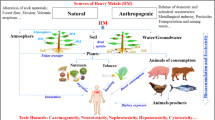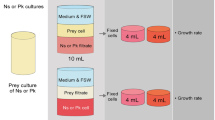Abstract
Rare earth elements (REE) are essential in many new technologies. While anthropogenic dispersion of REE into the environment are expected in the future, their biogeochemical fate and interactions at biological interfaces are still largely unexplored. Due to their chemical nature (generally trivalent and hard metals), REE can potentially compete among themselves or with other ubiquitous trivalent metals for uptake sites at the surface of aquatic organisms. In the current study, the bioavailability and uptake of gadolinium (Gd) was assessed in the green alga, Chlamydomonas reinhardtii, while in the presence of various trivalent elements (Al, Eu, Fe, Nd, Tm, and Y). In the absence of competitors, Gd uptake was well described by a Michaelis–Menten equation with an affinity constant (KGd) of 107.1 and a maximum internalization flux (Jmax) of 1.95 ± 0.09 × 10−2 amol µm−2 min−1. Neither Al(III) nor Fe(III) had notable effects on Gd uptake in the conditions tested; however, Gd uptake was reduced with increasing concentrations of other REE. These had binding constants with uptake sites very similar to that of Gd (KNd, Y, Tm, Eu = 107.0). Our results suggest that the different REE likely share common transport sites and that the biotic ligand model (BLM) can be used to predict their uptake.




Similar content being viewed by others
References
Aharchaou I, Beaubien C, Campbell PGC, Fortin C (2020) Lanthanum and cerium toxicity to the freshwater green alga Chlorella fusca: applicability of the Biotic Ligand Model. Environ Toxicol Chem 39:996–1005. https://doi.org/10.1002/etc.4707
Barry MJ, Meehan BJ (2000) The acute and chronic toxicity of lanthanum to Daphnia carinata. Chemosphere 41:1669–1674. https://doi.org/10.1016/S0045-6535(00)00091-6
Bau M, Dulski P (1996) Anthropogenic origin of positive gadolinium anomalies in river waters. Earth Planet Sc Lett 143:245–255. https://doi.org/10.1016/0012-821x(96)00127-6
Blaby-Haas CE, Merchant SS (2012) The ins and outs of algal metal transport. Biochim Biophys Acta 1823:1531–1552. https://doi.org/10.1016/j.bbamcr.2012.04.010
Campbell PGC, Fortin C (2013) Biotic Ligand Model. In: Férard J-F, Blaise C (eds) Encyclopedia of aquatic ecotoxicology. Springer, Dordrecht, pp 237–246. https://doi.org/10.1007/978-94-007-5704-2
Chen ZZ, Zhu L, Wilkinson KJ (2010) Validation of the biotic ligand model in metal mixtures: bioaccumulation of lead and copper. Environ Sci Technol 44:3580–3586. https://doi.org/10.1021/es1003457
Crémazy A, Campbell PGC, Fortin C (2013) The biotic ligand model can successfully predict the uptake of a trivalent ion by a unicellular alga below pH 6.50 but not above: possible role of hydroxo-species. Environ Sci Technol 47:2408–2415. https://doi.org/10.1021/es3038388
De Schamphelaere KAC, Nys C, Janssen CR (2014) Toxicity of lead (Pb) to freshwater green algae: development and validation of a bioavailability model and inter-species sensitivity comparison. Aquat Toxicol 155:348–359. https://doi.org/10.1016/j.aquatox.2014.07.008
El-Akl P, Smith S, Wilkinson KJ (2015) Linking the chemical speciation of cerium to its bioavailability in water for a freshwater alga. Environ Toxicol Chem 34:1711–1719. https://doi.org/10.1002/etc.2991
Erickson RJ (2013) The biotic ligand model approach for addressing effects of exposure water chemistry on aquatic toxicity of metals: genesis and challenges. Environ Toxicol Chem 32:1212–1214. https://doi.org/10.1002/etc.2222
François L, Fortin C, Campbell PGC (2007) pH modulates transport rates of manganese and cadmium in the green alga Chlamydomonas reinhardtii through non-competitive interactions: implications for an algal BLM. Aquat Toxicol 84:123–132. https://doi.org/10.1016/j.aquatox.2007.02.019
Gong B, He E, Xia B, Ying R, Peijnenburg WJGM, Liu Y, Qiu H (2020) Bioavailability and phytotoxicity of rare earth metals to Triticum aestivum under various exposure scenarios. Ecotoxicol Environ Saf 205:111346. https://doi.org/10.1016/j.ecoenv.2020.111346
Goodenough KM, Wall F, Merriman D (2018) The rare earth elements: demand, global resources, and challenges for resourcing future generations. Nat Resour Res 27:201–216. https://doi.org/10.1007/s11053-017-9336-5
Gwenzi W, Mangori L, Danha C, Chaukura N, Dunjana N, Sanganyado E (2018) Sources, behaviour, and environmental and human health risks of high-technology rare earth elements as emerging contaminants. Sci Total Environ 636:299–313. https://doi.org/10.1016/j.scitotenv.2018.04.235
Harris EH (ed) (1989) The Chlamydomonas Sourcebook. Academic Press, Toronto
Joonas E, Aruoja V, Olli K, Syvertsen-Wiig G, Vija H, Kahru A (2017) Potency of (doped) rare earth oxide particles and their constituent metals to inhibit algal growth and induce direct toxic effects. Sci Total Environ 593:478–486. https://doi.org/10.1016/j.scitotenv.2017.03.184
Kola H, Wilkinson KJ (2005) Cadmium uptake by a green alga can be predicted by equilibrium modelling. Environ Sci Technol 39:3040–3047. https://doi.org/10.1021/es048655d
Kulaksiz S, Bau M (2013) Anthropogenic dissolved and colloid/nanoparticle-bound samarium, lanthanum and gadolinium in the Rhine River and the impending destruction of the natural rare earth element distribution in rivers. Earth Planet Sc Lett 362:43–50. https://doi.org/10.1016/j.epsl.2012.11.033
Lavoie M, Campbell PGC, Fortin C (2012) Extending the biotic ligand model to account for positive and negative feedback interactions between cadmium and zinc in a freshwater alga. Environ Sci Technol 46:12129–12136. https://doi.org/10.1021/Es302512r
Le Goff S, Barrat JA, Chauvaud L, Paulet YM, Gueguen B, Ben Salem D (2019) Compound-specific recording of gadolinium pollution in coastal waters by great scallops. Sci Rep. https://doi.org/10.1038/s41598-019-44539-y
Leguay S, Campbell PGC, Fortin C (2016) Determination of the free-ion concentration of rare earth elements by an ion-exchange technique: implementation, evaluation and limits. Environ Chem 13:478–488. https://doi.org/10.1071/en15136
Lofts S, Tipping E, Hamilton-Taylor J (2008) The chemical speciation of Fe(III) in freshwaters. Aquat Geochem 14:337–358. https://doi.org/10.1007/s10498-008-9040-5
Lürling M, Tolman Y (2010) Effects of lanthanum and lanthanum-modified clay on growth, survival and reproduction of Daphnia magna. Water Res 44:309–319. https://doi.org/10.1016/j.watres.2009.09.034
Marsac R, Davranche M, Gruau G, Dia A, Pédrot M, Le Coz-Bouhnik M, Briant N (2013) Effects of Fe competition on REE binding to humic acid: origin of REE pattern variability in organic waters. Chem Geol 342:119–127. https://doi.org/10.1016/j.chemgeo.2013.01.020
Mebane CA, Chowdhury MJ, De Schamphelaere KAC, Lofts S, Paquin PR, Santore RC, Wood CM (2020) Metal bioavailability models: current status, lessons learned, considerations for regulatory use, and the path forward. Environ Toxicol Chem 39:60–84. https://doi.org/10.1002/etc.4560
Migaszewski ZM, Galuszka A (2016) The use of gadolinium and europium concentrations as contaminant tracers in the Nida River watershed in south-central Poland. Geol Q 60:67–76. https://doi.org/10.7306/gq.1241
Pang X, Li D, Peng A (2002) Application of rare-earth elements in the agriculture of China and its environmental behavior in soil. Environ Sci Pollut Res Int 9:143–148. https://doi.org/10.1007/BF02987462
Perrat E, Parant M, Py JS, Rosin C, Cossu-Leguille C (2017) Bioaccumulation of gadolinium in freshwater bivalves. Environ Sci & Pollut Res 24:12405–12415. https://doi.org/10.1007/s11356-017-8869-9
Ramalho J, Semelka RC, Ramalho M, Nunes RH, AlObaidy M, Castillo M (2016) Gadolinium-based contrast agent accumulation and toxicity: an update. Am J Neuroradiol 37:1192–1198. https://doi.org/10.3174/ajnr.A4615
Rogowska J, Olkowska E, Ratajczyk W, Wolska L (2018) Gadolinium as a new emerging contaminant of aquatic environments. Environ Toxicol Chem 37:1523–1534. https://doi.org/10.1002/etc.4116
Shannon RD (1976) Revised effective ionic radii and systematic studies of interatomic distances in halides and chaleogenides. Acta Cryst 32:751–767. https://doi.org/10.1107/S0567739476001551
Slaveykova VI, Wilkinson KJ (2005) Predicting the bioavailability of metals and metal complexes: critical review of the biotic ligand model. Environ Chem 2:9–24. https://doi.org/10.1071/En04076
Tai PD, Zhao Q, Su D, Li PJ, Stagnitti F (2010) Biological toxicity of lanthanide elements on algae. Chemosphere 80:1031–1035. https://doi.org/10.1016/j.chemosphere.2010.05.030
Tan Q-G, Yang G, Wilkinson KJ (2017) Biotic ligand model explains the effects of competition but not complexation for Sm biouptake by Chlamydomonas reinhardtii. Chemosphere 168:426–434. https://doi.org/10.1016/j.chemosphere.2016.10.051
Tipping E (2005) Modelling Al competition for heavy metal binding by dissolved organic matter in soil and surface waters of acid and neutral pH. Geoderma 127:293–304. https://doi.org/10.1016/j.geoderma.2004.12.003
Tipping E, Rey-Castro C, Bryan SE, Hamilton-Taylor J (2002) Al(III) and Fe(III) binding by humic substances in freshwaters, and implications for trace metal speciation. Geochim Cosmochim Acta 66:3211–3224. https://doi.org/10.1016/S0016-7037(02)00930-4
Voncken JHL (2016) The rare earth elements—a special group of metals. In: The rare earth elements: an introduction. SpringerBriefs in earth sciences. Springer, Cham, pp 1–13. https://doi.org/10.1007/978-3-319-26809-5_1
Worms IAM, Parthasarathy N, Wilkinson KJ (2007) Ni uptake by a green alga. 1. Validation of equilibrium models for complexation effects. Environ Sci Technol 41:4258–4263. https://doi.org/10.1021/es0630339
Yang G, Wilkinson KJ (2018) Biouptake of a rare earth metal (Nd) by Chlamydomonas reinhardtii—Bioavailability of small organic complexes and role of hardness ions. Environ Pollut 243:263–269. https://doi.org/10.1016/j.envpol.2018.08.066
Yang G, Tan QG, Zhu L, Wilkinson KJ (2014) The role of complexation and competition in the biouptake of europium by a unicellular alga. Environ Toxicol Chem 33:2609–2615. https://doi.org/10.1002/etc.2722
Acknowledgments
The authors thank J. Perreault, L. Rancourt, and K. Racine for their technical help and S. Hepditch for language assistance. Environment and Climate Change Canada (Contribution Agreement for Metals in the Environment: Mitigating Environmental Risk and Increasing Sustainability, GCXE17S011), the Natural Sciences and Engineering Research Council of Canada (Grant STPGP 521467-18), and the Fonds de recherche du Québec–Nature et technologies (Grant 2018-PR-207155) are acknowledged for funding the present study. C. Fortin was supported by the Canada Research Chair Programme.
Author information
Authors and Affiliations
Corresponding author
Electronic supplementary material
Below is the link to the electronic supplementary material.
Rights and permissions
About this article
Cite this article
Aharchaou, I., Bahloul, F. & Fortin, C. Competition Among Trivalent Elements (Al, Eu, Fe, Gd, Nd, Tm, and Y) for Uptake in Algae and Applicability of the Biotic Ligand Model. Arch Environ Contam Toxicol 81, 612–620 (2021). https://doi.org/10.1007/s00244-020-00786-z
Received:
Accepted:
Published:
Issue Date:
DOI: https://doi.org/10.1007/s00244-020-00786-z




